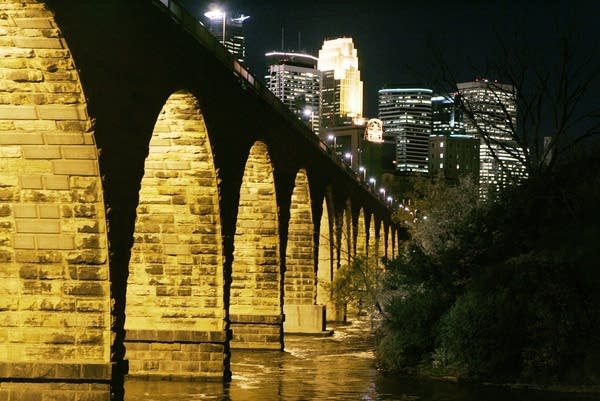5 things to do in the Twin Cities (when everyone else is gone)

Go Deeper.
Create an account or log in to save stories.
Like this?
Thanks for liking this story! We have added it to a list of your favorite stories.
Like many places that endure long, difficult winters, Minnesota comes alive when the weather warms up.
So many people from the Twin Cities -- as Minneapolis and St. Paul are known -- head to lakes in northern parts of the state that the city's attractions truly open up to out-of-towners.
And as in any urban area, some of the best are free.
• Also: Things to do statewide
Turn Up Your Support
MPR News helps you turn down the noise and build shared understanding. Turn up your support for this public resource and keep trusted journalism accessible to all.
1: Stone Arch Bridge and Mississippi River Overlook

Minneapolis traces its roots to lumber and grain milling. History buffs can get a feel for those early days with an amble across the Stone Arch Bridge just north of downtown. The mighty St. Anthony Falls powered mills that helped build the city, and the Falls still roar today, misting pedestrians and cyclists as they read plaques about the history.
Look south toward downtown to see the few remaining grain elevators, topped by the iconic GOLD MEDAL FLOUR sign first erected more than a century ago. Nearby Mill Ruins Park offers a tumbledown cross-section of old millworks. If that's not enough, the Mill City Museum (not free) has more on the city's flour past, with hands-on activities for kids and adults.
A block away, get another fine view of Minneapolis' revitalized riverfront from the Guthrie Theater, where Jean Nouvel's "Endless Bridge" juts toward the river on one of the longest occupied cantilevers in the world. The ninth floor offers visitors a fun test of courage if they're willing to step onto a glass floor, though it's sadly distorted by the yellow glass enclosure.
2: Minneapolis Institute of Arts

The Walker Art Center is known for modern art but the place to see more traditional treasures is the Minneapolis Institute of Arts. Its 87,000 objects include Van Gogh's "Olive Trees," Rembrandt's "Lucretia," a nearly 2,000-year-old bronze horse from the Han dynasty, and a late 1700s Charleston drawing room, once part of a wealthy merchant's home. Two blocks away is "Eat Street," a cavalcade of ethnic restaurants along three blocks of Nicollet Avenue.
3: Minnehaha Falls

A popular summer spot is Minnehaha Park, a sprawling green space in the city's southeast quadrant that's hosted family picnics and outdoor concerts for generations.
The star attraction is the falls, named in the Henry Wadsworth Longfellow poem "Song of Hiawatha" and at their roaring best in June when water volume is typically high. The Minnehaha Creek tumbles 53 feet (16 meters) over jagged limestone into a basin beneath a sort of half-cave before it continues into the Mississippi River. Visitors can get a view from above the falls or take stairs to creek level to see them from below.
There's a casual seafood-themed joint in the park pavilion; enjoy a fish taco (not free) on the patio watching families figuring out quad bike rentals.
4: Como Park Zoo and Observatory

St. Paul's Como Park Zoo is small enough to be kid-friendly, but big enough to hold lions and tigers and polar bears, oh my! Not to mention a Gorilla Forest and Wolf Woods. The Sparky the Sea Lion show has been a favorite since 1956, with a succession of performers as Sparky; the current mammal turns 14 this summer.
Zoo keepers give daily free talks. The glassed-in Conservatory shows off tropical and other exotic plants year-round in a variety of indoor and outdoor gardens, including a Japanese garden with a bonsai pavilion. It's a popular venue for weddings and a refuge from harsh Minnesota winters. Admission and parking are free; suggested donation, $3 for adults, $2 for children. Rides on 100-year-old Cafesjian's Carousel and attractions in the Como Town amusement park cost extra.
5: Summit Avenue Stroll

Take a trip to the past with a stroll down St. Paul's Summit Avenue, home to stately Victorian mansions, massive churches and Mount Zion Temple (founded by the first Jewish settlers to Minnesota), colleges, groomed lawns and towering trees.
Bicyclists cruise the 4-mile (6.4-kilometer) stretch of pavement and joggers pound the wide sidewalks, but you can imagine Jazz Age author F. Scott Fitzgerald, whose birthplace is a few blocks off Summit, sauntering down the shady street. You might even run into humorist Garrison Keillor, whose Georgian Revival home is on Summit, or Gov. Mark Dayton, who lives with his German shepherds in the Governor's Mansion donated by a lumberman's family to the state in 1965.
Take in sculptures such as the Nathan Hale statue honoring the hanged Revolutionary War spy or the Art Deco "Indian Hunter and His Dog" sculpture by St. Paul native Paul Manship. Drink in the view of the Mississippi River Valley from the small park near the University Club of St. Paul. And check out the imposing rough stone James J. Hill House, built by the Gilded Age railroad baron.


